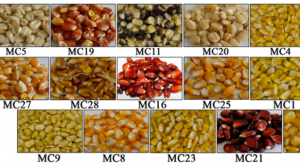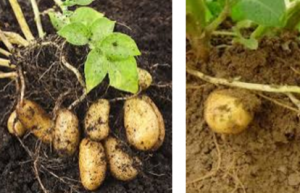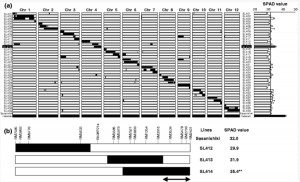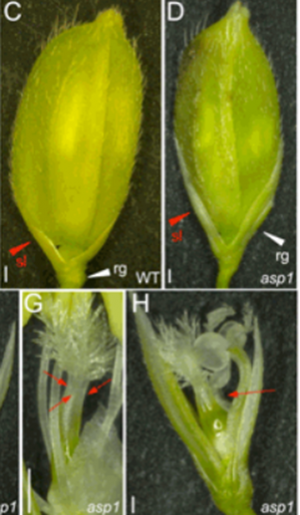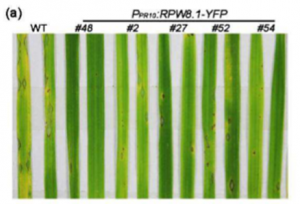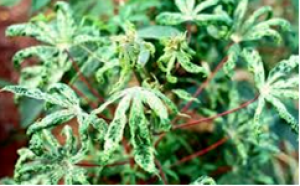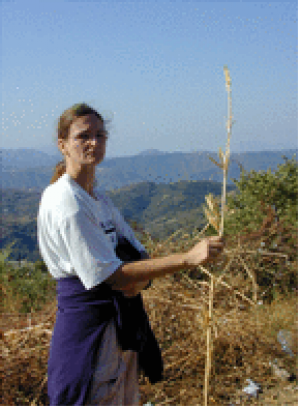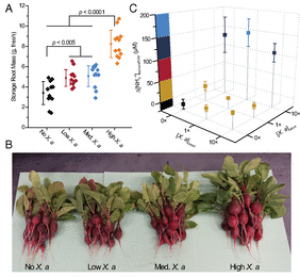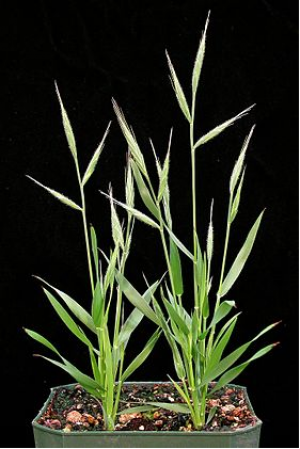High-carotenoid (HC) maize, a biofortified staple crop which accumulates β-carotene, β-cryptoxanthin, lutein and zeaxanthin, was used as a feed component in a chicken feeding trial to assess the bioavailability of provitamin A (PVA) carotenoids in the kernel matrix compared to the synthetic and natural color additives routinely used in the poultry industry. We found that the PVA carotenoids in HC maize were not metabolized in the same manner
For many commercial potato cultivars, tuber yield is optimal at average daytime temperatures in the range of 14–22 °C. Further rises in ambient temperature can reduce or completely inhibit potato tuber production, with damaging consequences for both producer and consumer. The aim of this study was to use a genetic screen based on a model tuberization assay to identify quantitative trait loci (QTL) associated with enhanced tuber yield. A candidate gene encoding HSc70 was identified within one of the three QTL intervals associated with elevated yield in a Phureja–Tuberosum hybrid diploid potato population (06H1). A particular HSc70 allelic variant was linked to elevated yield in the 06H1 progeny
As the largest class of natural products found in all living organisms, terpenoids play essential roles in plant growth, development, respiration, photosynthesis, and environmental interactions. Geranylgeranyl diphosphate (GGPP), a precursor for several terpenoid metabolic branches including chlorophyll, carotenoid, and gibberellin biosynthesis, is produced by GGPP synthase (GGPPS) in plastids. We discovered that rice GGPPS recruiting protein (GRP), which forms a heterodimer with the only plastidic GGPPS, controls GGPPS dimerization state and enhances its catalytic properties.
Gene and genome duplication fosters genetic novelty, but redundant gene copies would undergo mutational decay unless preserved via selective or neutral forces. Molecular mechanisms mediating duplicate preservation remain incompletely understood. Several recent studies showed an association between DNA methylation and expression divergence of duplicated genes and suggested a role of epigenetic mechanism in duplicate retention. Here, we compare genome-wide gene-body CG methylation (BCGM) and duplicate gene expression between a rice mutant null for OsMet1-2(a major CG methytransferase in rice) and its isogenic wild-type.
The Arabidopsis gene RESISTANCE TO POWDERY MILDEW8.1 (RPW8.1) confers resistance to virulent fungal and oomycete pathogens that cause powdery mildew and downy mildew, respectively. However, the underlying mechanism remains unclear. Here, we show that ectopic expression of RPW8.1 boosts pattern-triggered immunity (PTI) resulting in enhanced resistance against different pathogens in both Arabidopsis and rice. In Arabidopsis, transcriptome analysis revealed that ectopic expression of RPW8.1-YFP constitutively up-regulates expression of many pathogen-associated molecular pattern-(PAMP-) inducible genes.
This study aimed to develop a methodology for eliminating cassava frogskin disease (CFSD) from in vitro shoot tip culture by associating thermotherapy and tetracycline. Cuttings from different accessions (BGM0232, BGM0315, BGM0464, BGM584, BGM0841, and BGM1342), infected with CFSD according to visual inspection of the disease symptoms, were used for cleaning.
Cornell University researchers have found out how E. coli bacteria defend themselves against antibiotics and other poisons. When undesirable molecules show up, the bacterial cell opens a tunnel through its cell wall and pumps out the intruders. According to Peng Chen, professor of chemistry and chemical biology, scientists have hypothesized on the assembly of these tunnels for a long time. Now the team has seen them.
The development of agricultural societies, one of the most transformative events in human and ecological history, was made possible by plant and animal domestication. Plant domestication began 12,000–10,000 y ago in a number of major world areas, including the New World tropics, Southwest Asia, and China, during a period of profound global environmental perturbations as the Pleistocene epoch ended and transitioned into the Holocene.
The nitrogen cycle and the fixation of atmospheric N2 into ammonium are crucial to global food production. The industrial Haber–Bosch process facilitates half the global nitrogen fixation in the form of ammonia but it is energy- and resource-intensive, using natural gas as the source of energy and hydrogen at elevated temperature and pressure. Our alternative approach synthesizes ammonium from N2 and H2O at ambient conditions powered by water splitting, which may be driven renewably.
A key feature in the evolution of all vernalization systems is a cold-regulated component. In pooid grasses, up-regulation of the flowering promoter VERNALIZATION1 (VRN1) by prolonged cold is a key feature of vernalization, although little is known about the genes that repress VRN1 prior to cold exposure or activate it afterward. Here, we report the identification of REPRESSOR OF VERNALIZATION1 (RVR1), a repressor of VRN1 that is involved in creating a vernalization requirement in Brachypodium distachyon. RVR1 is present in all sequenced flowering plant genomes but is not found outside the plant kingdom. This report describes a role for the RVR1 class of genes in plants and an upstream component of the VRN1 regulatory system.


 Curently online :
Curently online :
 Total visitors :
Total visitors :
